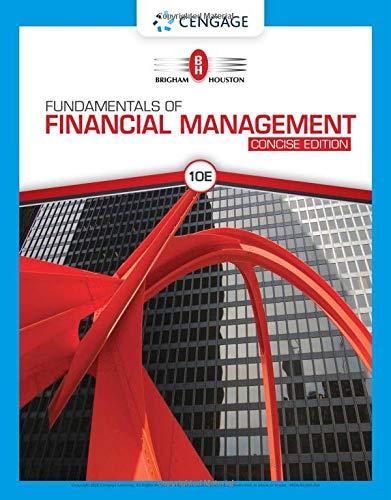
Concept explainers
a)
1)
To determine: Total dividends of Company B for 2019, when dividend payments forces to grow at long-run growth rate in earnings.
a)
1)
Explanation of Solution
Given statement:
Past 10 year earnings is 8%,
Dividends paid in 2018 is $2.6 million,
Net income $9.8 million,
Earnings are expected to jump $12.6 million in 2019
Debt ratio is 35%
Calculation of total dividends for 2019:
Hence, total dividends in 2019 is $2,808,000
2)
To determine: Total dividends of Company B for 2019, when it continues the same dividend pay-out ratio of 2018.
2)
Explanation of Solution
Calculation of DPS in 2018:
For calculating total dividends paid in 2019, we must find pay-out ratio of 2018.
Therefore, pay-out ratio is 26.53%
Calculation of total dividends in 2019:
Hence, total dividends in 2019 are $3.34 million.
3)
To determine: Total dividends of Company B for 2019, when it utilizes pure residual policy in the form of dividends. (35% ($7.3million) financed by debt)
3)
Explanation of Solution
Debt financing is 35% then equity financing is 1-debt financing.
Calculation of total dividends in 2019:
Hence, total dividends in 2019 are $7,855,000
All of the equity finance is completed with re-invested
4)
To determine: Total dividends of Company B for 2019, when it uses regular dividend plus extras policy, regular dividend founded on long run growth and extras on residual policy.
4)
Explanation of Solution
Regular dividends would be 8% above the 2018 dividends.
The residual policy calls for $7,855,000. Therefore, the extra dividends would be,
Calculation of extra dividends:
Hence, extra dividends in 2019 are $5,047,000
Thus, an even higher use of excess funds may be a stock repurchase.
b)
To discuss: Policies recommended by person X to the company and restrict those to listed ones.
b)
Explanation of Solution
Policy number 4, supported the regular dividend with an extra, appears most reasonable. If this is implemented properly, it would lead to accurate capital budget and accurate financing of that budget, and it might offer correct signals to investors.
c)
To discuss: Whether the dividend in 2019 is $9,000,000 is reasonable from the results obtained in part (a) and (b).
c)
Explanation of Solution
A dividend of $9,000,000 in 2019 might be slightly low. It is observed that the capital budget is too substantial, and that more dividends ought to be paid out. Noticeably, it is true to make sure that the organization can be gaining low
In any case, if the current year’s projects resemble those of historical years, at that point the pay-out seems, by all accounts, to be marginally low.
Want to see more full solutions like this?
Chapter 15 Solutions
INTERMEDIATE FINANCIAL MANAGEMENT
- What is an annuity?* An investment that has no definite end and a stream of cash payments that continues forever A stream of cash flows that start one year from today and continue while growing by a constant growth rate A series of equal payments at equal time periods and guaranteed for a fixed number of years A series of unequal payments at equal time periods which are guaranteed for a fixed number of yearsarrow_forwardIf you were able to earn interest at 3% and you started with $100, how much would you have after 3 years?* $91.51 $109.27 $291.26 $103.00arrow_forwardNo AI 2. The formula for calculating future value (FV) is* FV = PV/(1+r)^n FV = PV/(1+r)*n FV = PV x (1+r)^n FV = PV x (1+r)*narrow_forward
- Calculate Value of R??arrow_forwardHello tutor need barrow_forwardMoose Enterprises finds it is necessary to determine its marginal cost of capital. Moose’s current capital structure calls for 50 percent debt, 30 percent preferred stock, and 20 percent common equity. Initially, common equity will be in the form of retained earnings (Ke) and then new common stock (Kn). The costs of the various sources of financing are as follows: debt, 9.6 percent; preferred stock, 9 percent; retained earnings, 10 percent; and new common stock, 11.2 percent. a. What is the initial weighted average cost of capital? (Include debt, preferred stock, and common equity in the form of retained earnings, Ke.) b. If the firm has $18 million in retained earnings, at what size capital structure will the firm run out of retained earnings? c. What will the marginal cost of capital be immediately after that point? (Equity will remain at 20 percent of the capital structure, but will all be in the form of new common stock, Kn.) d. The 9.6 percent cost of debt referred to earlier…arrow_forward
 Intermediate Financial Management (MindTap Course...FinanceISBN:9781337395083Author:Eugene F. Brigham, Phillip R. DavesPublisher:Cengage Learning
Intermediate Financial Management (MindTap Course...FinanceISBN:9781337395083Author:Eugene F. Brigham, Phillip R. DavesPublisher:Cengage Learning Fundamentals Of Financial Management, Concise Edi...FinanceISBN:9781337902571Author:Eugene F. Brigham, Joel F. HoustonPublisher:Cengage Learning
Fundamentals Of Financial Management, Concise Edi...FinanceISBN:9781337902571Author:Eugene F. Brigham, Joel F. HoustonPublisher:Cengage Learning EBK CONTEMPORARY FINANCIAL MANAGEMENTFinanceISBN:9781337514835Author:MOYERPublisher:CENGAGE LEARNING - CONSIGNMENT
EBK CONTEMPORARY FINANCIAL MANAGEMENTFinanceISBN:9781337514835Author:MOYERPublisher:CENGAGE LEARNING - CONSIGNMENT





